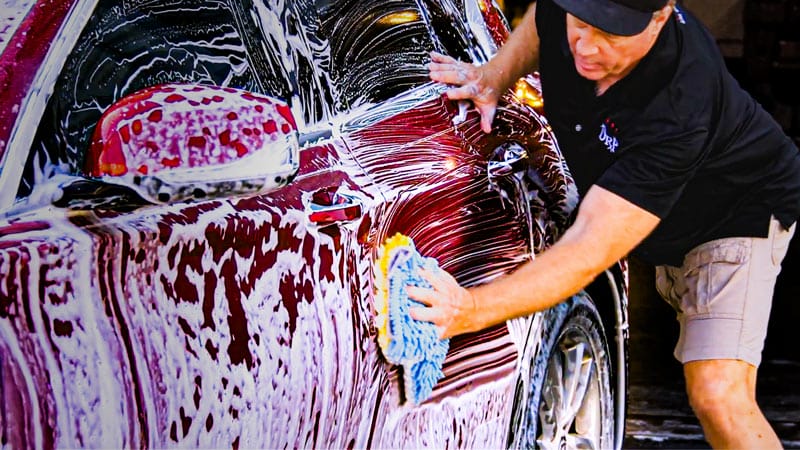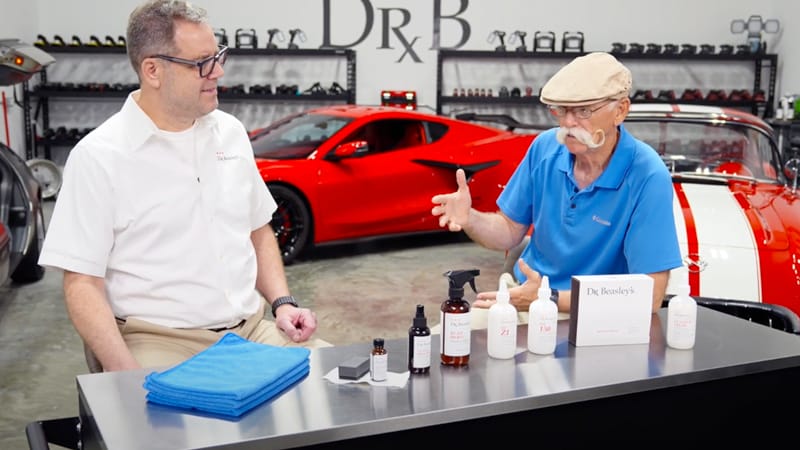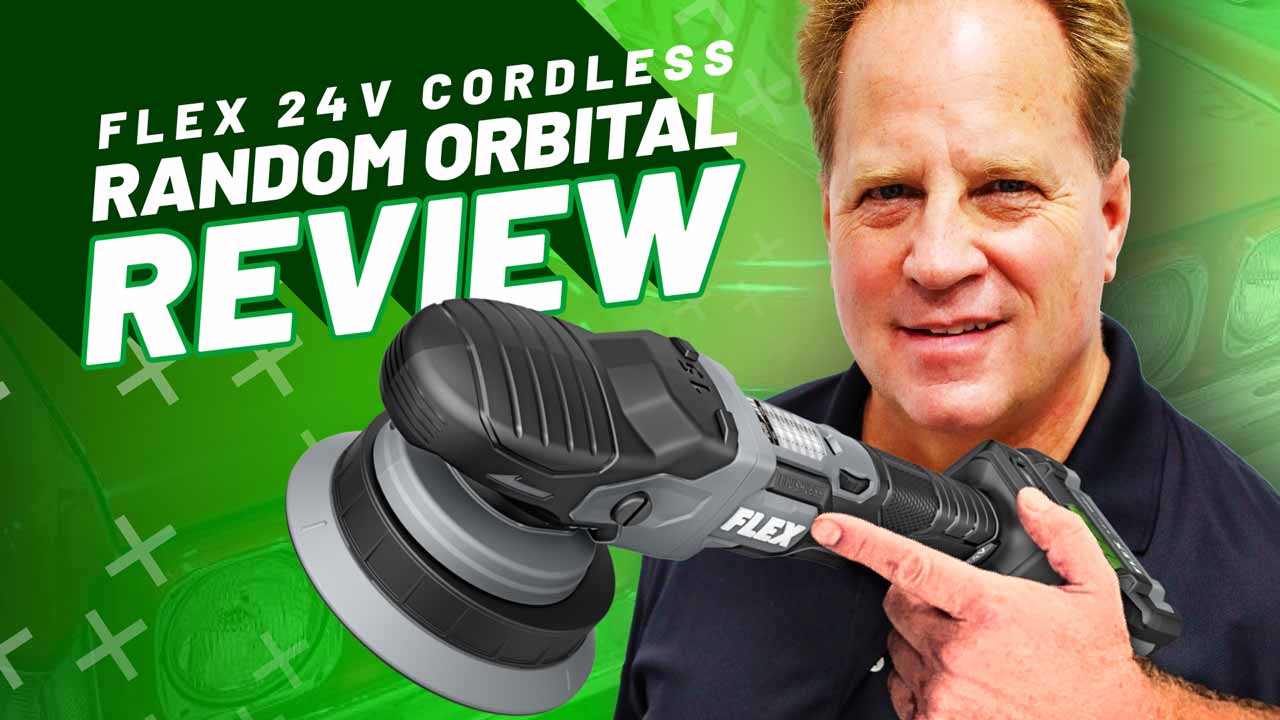Last Updated November 27, 2024
- [ Flex FX3321 24V 15MM Random Orbital Cordless Polisher Review ]
- [ Learn About Random Orbital Polishers ]
Read My Other 24V Flex Polisher Reviews!
This is the second of three reviews for the new 24 volt FLEX polishers. Below are the links to the other two tool reviews. As I worked through using these tools, making videos, and writing these reviews, you can watch the transformation and extreme makeover to the 1970 Pontiac Grand Prix Model SJ as I used all three tools to torture test the tools and the lithium battery technology.
- Review: FLEX FX3331 24 Volt Cordless 8mm Gear-driven Orbital Polisher aka CBEAST
- Review: FLEX FX3311 24 Volt Cordless Rotary Polisher
I’m a big proponent for Flex polishers and sanders and have been for years. I know so much about them, I’ve written and published physical guidebooks to their polishers — I believe some of them are still on Amazon.
Because of my expertise with their tools, Flex has sent me many tools over the years for testing. When FLEX introduced their first cordless XFE15 150 18.0 Free Spinning 15mm Long Stroke Random Orbital Polisher, at SEMA in 2017, I’m honored to say, I was the first person to receive this new tool and in fact, FLEX gave me the Number 1 Production Unit. I was given a prototype for this tool in the spring of 2016.
Fun fact: The nickname for this tool is THE FINISHER, a name chosen by FLEX from a contest held in the summer of 2016 on the AutogeekOnline.net discussion forum. Forum member Dan Tran submitted his suggestion in post #49 as THE FINISHER.
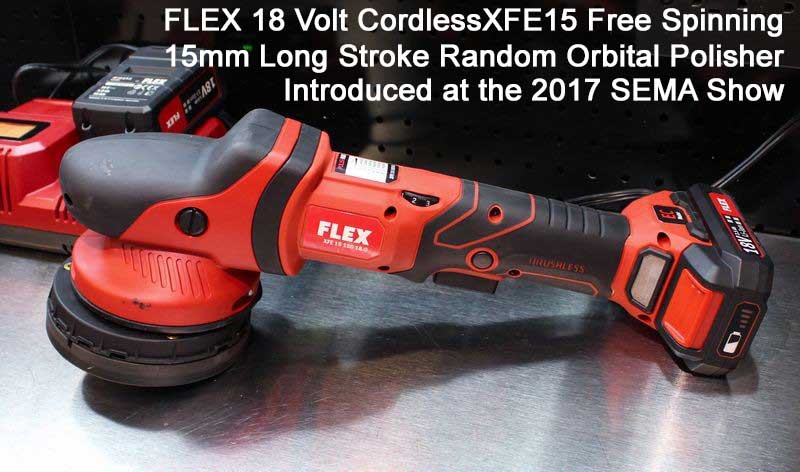
Now Flex has introduced a new 24V version of their free spinning random orbital: the Flex FX3321 24V 15MM Random Orbital Polisher. In this article, I’ll explain what makes a free-spinning random orbital different from a gear driven orbital or a rotary polisher and provide an in-depth review and unboxing of Flex’s new tool.

What is a “Free Spinning” Random Orbital Polisher?
The Flex FX3321 is a 15mm free spinning random orbital polisher. Here’s what that means:
- Random Orbital: The polisher moves a buffing pad in both a circle and a secondary circle inside the rotating circle to create a dual action oscillation pattern when buffing.
- Free Spinning: The polisher spins the buffing pad on a free spinning axis as opposed to a fixed gear that drives the rotating action. This means the pad will stop spinning if you press too hard.
The upside for any brand of free spinning random orbital polisher is they tend to be much smoother to hold and operate versus gear-driven orbitals and rotary polishes.
The downside is that all brands of free spinning random orbital polishers suffer from what is referred to as pad stalling in the detailing world. This means if you’re not holding the pad perfectly flat to the surface, or if you’re buffing out concave body panels, where the paint surface is not flat, the spinning buffing pad can and will tend to stall-out or slow down.
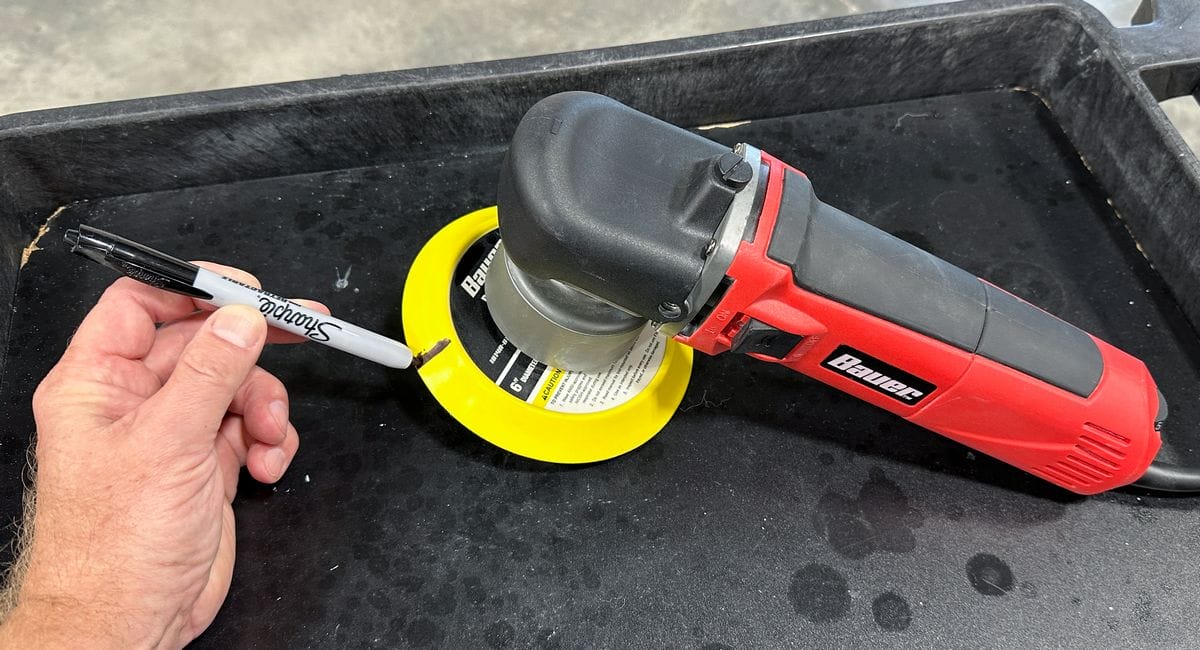
In a worst case scenario, the pad will simply vibrate and jiggle against the paint. This is less of a big deal when using these types of tools for light polishing or finishing work, but it is a big deal if you’re trying to do major paint correction by removing swirls, scratches, water spots and oxidation.
When pad stalling takes place, defect removal is dramatically reduced. In my experience, all brands of free spinning random orbital polishers require more time when doing paint correction when compared to gear-driven orbital, (zero pad stalling), and/or rotary polishers, (zero pad stalling).
To give you an idea of what the rotation and oscillation pattern looks like compared to rotary polishers and fixed gear-driven orbital polishers, check out the diagram below. The FINISHER is on the far right.
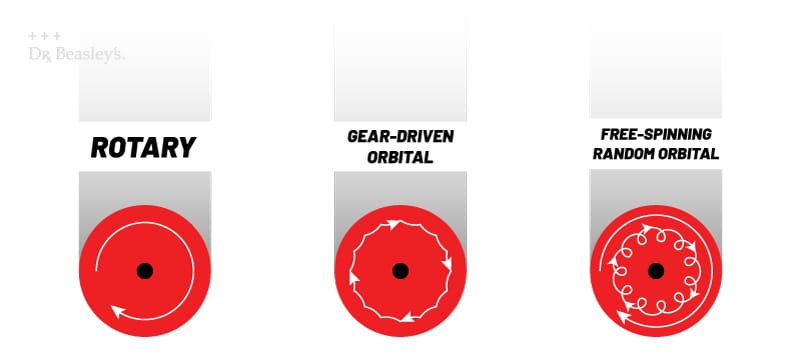
How Can I Tell if a Polisher is Free Spinning?
It’s super easy to tell any free spinning random orbital polisher from gear-driven orbitals and rotary polishers.
If you can FREELY spin the backing plate back and forth in two directions with your finger, this is a free spinning random orbital polisher. With a gear-driven orbital or even a rotary, (both are gear-driven or direct-drive), you will need to actually grab the backing plate with your hand and forcibly rotate or spin it.
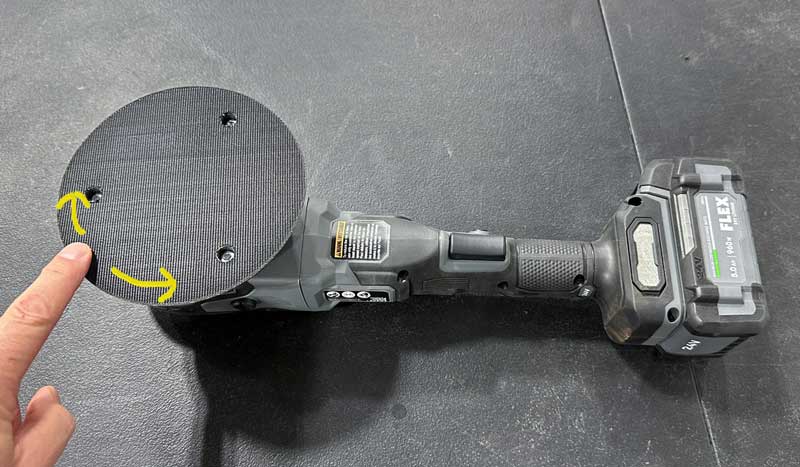
Works Best for Light Duty Work — Avoid Heavy Correction
When Nick Rutter and I ran a contest on the Autogeek forums to name the original XFE15, the name that won out of hundreds of other options was the “FINISHER”.
The reason why is because the word finisher accurately describes what and how this tool works. Due to the long-stroke, free spinning random orbital design for the drive mechanism, this tool is better for light duty work, like doing a finishing step AFTER first doing a heavier paint correction step using either a gear-driven orbital or a rotary polisher. For light paint correction for cars that don’t need a heavy paint correction step, like brand new cars.
In other words, this tool would not be correctly nicknamed if it were called the Heavy Duty Paint Correction Polisher, due to the pad stalling characteristic.
My comment is, if the FLEX brand of 15mm long stroke random orbital polisher is most accurately described as a finishing tool, this also holds true for ALL BRANDS of long-stroke, free spinning random orbital polishes.
That is to say, any 12mm, 15mm, 21mm and/or 25mm free spinning random orbital polishers will all be best used for light duty polishing, not heavy paint correction. Just my opinion based upon experience. FWIW
Nothing wrong with this if you describe yourself as a do-it-yourself or enthusiast detailer and you’re working on vehicles in new or like-new condition and you’re not in a big hurry to do the paint correction step.

If you’re a professional detailer or like me, you simply like to buff out a car, that is do the paint correction step as fast as possible, then you should look at a gear-driven orbital polisher like the FLEX BEAST, Supa BEAST and/or the CBEAST – which are all 8mm gear-driven orbital polishers. With gear-driven orbitals, you get the power of a rotary polisher without the risk of burning through the paint or putting holograms into the paint.
Flex FX3321 Technical Specifications
| No-load speed | 1350-4350 RPM |
| Brushless | Yes |
| Max. polishing pad diameter | 6 in |
| Max. back-up pad diameter | 6 in |
| Orbit | 0.59 in (15MM) |
| Orbit Rate (No Load) | 2,700-8,700 OPM |
| Tool Weight | 4.6 lbs |
| Tool Height | 5.4 in |
| Tool Length | 15.2 in |
| Tool Width | 3.8 i |
Unboxing the Flex FX3321-2 Kit
Let’s open the box and take a look at what’s included in the FLEX FX3321-2 Kit.
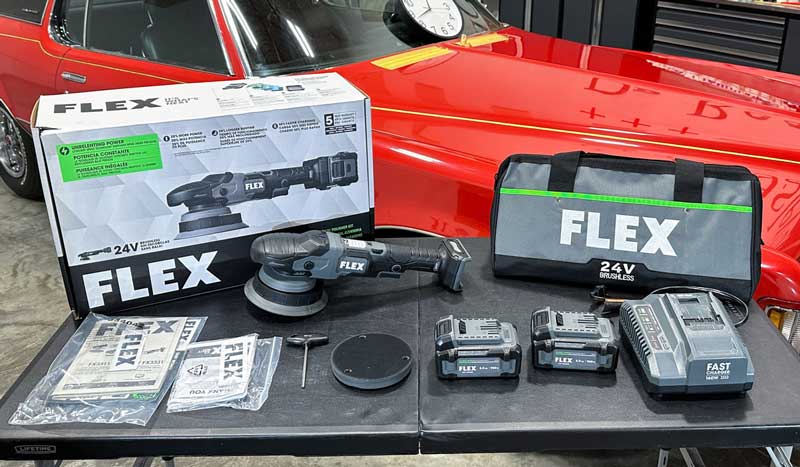
- 24 Volt FLEX 15mm Orbital Polisher – Part number tool only FX3321 – in kit form FX3321-2C
- 2 each 5 Amp – 960 Watt Lithium Cylindrical Cell Batteries
- 1 each 160 Watt Battery Charger
- 1 each 6” Backing Plate
- 1 each 5” Backing Plate
- 1 each Backing Plate Wrench
- FLEX Storage Bag
- Owner’s Tool Manual
- Owner’s Charger Manual
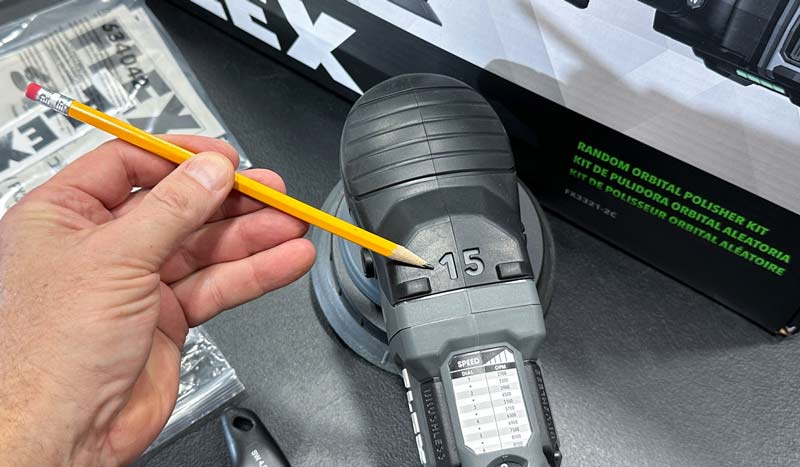
Easy Tool Identification: FLEX recessed the number 15 into the top of the head of the polisher to make it easy to identify the type of tool.
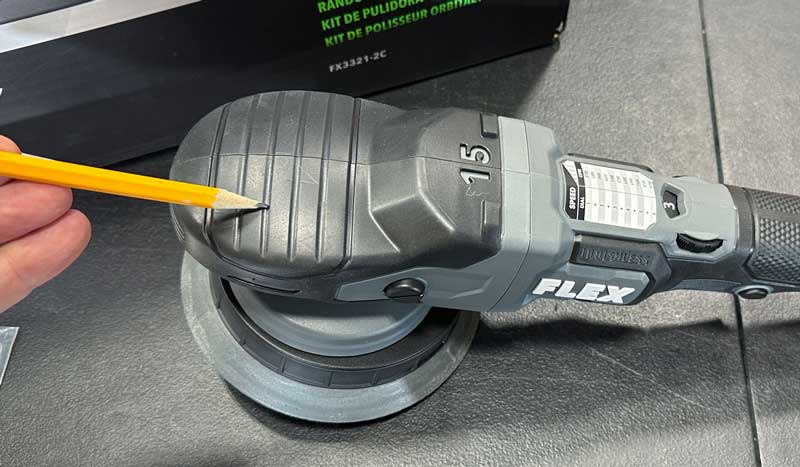
Ego Rubber Overmold: The head of the tool has a rubber overmold with ribs to make gripping and controlling the tool easy.
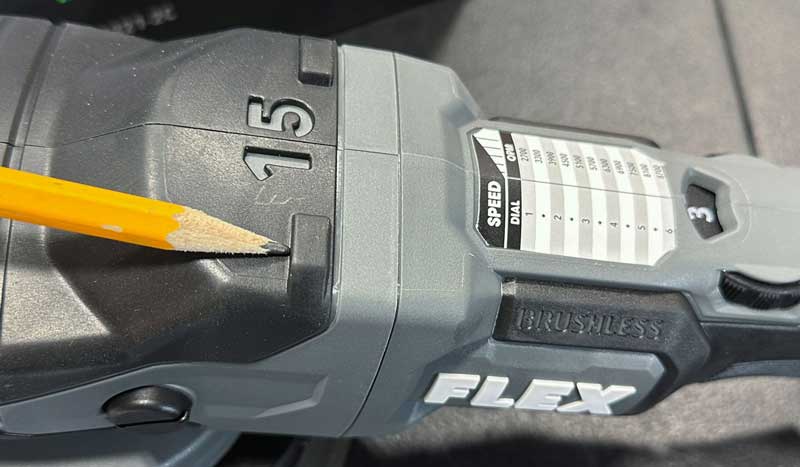
Tool Rest: The middle of the tool body has built in flat tool rests. These come in handy because when not in use, you can lay it upside down and it remains stable instead of rolling over onto its side.
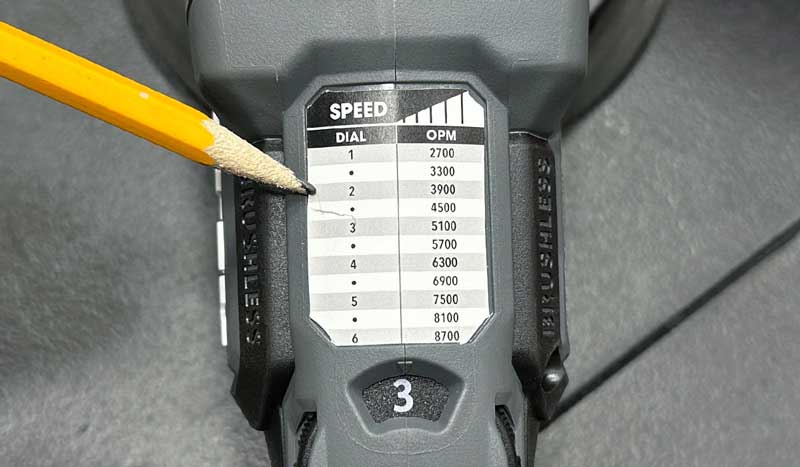
Ease To Read Speed Chart: Conveniently located on the top of the tool, just in front of the speed dial adjuster is an easy-to-read speed setting to OPM indicator chart.
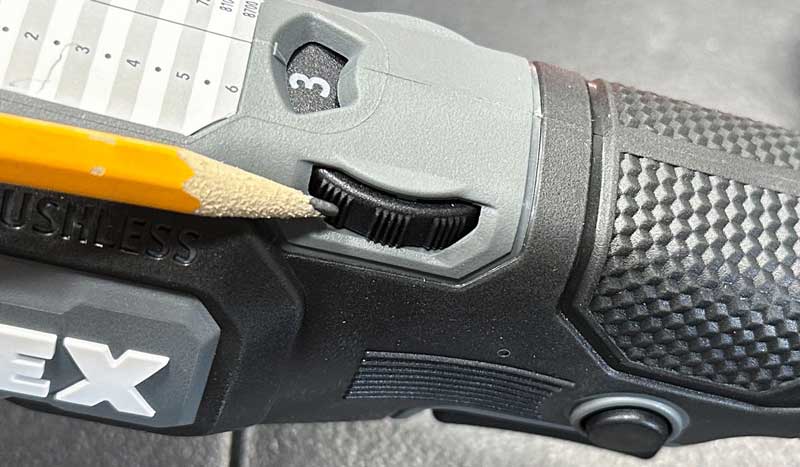
Ambidextrous 11-Speed Control Dial and Large Speed Indicator: With access to the dial on either side of the tool, it’s easy for anyone to set and/or adjust the speed setting. There are also detents in the speed dial to lock in one of 11 speed settings to suit your taste and tool function needs.
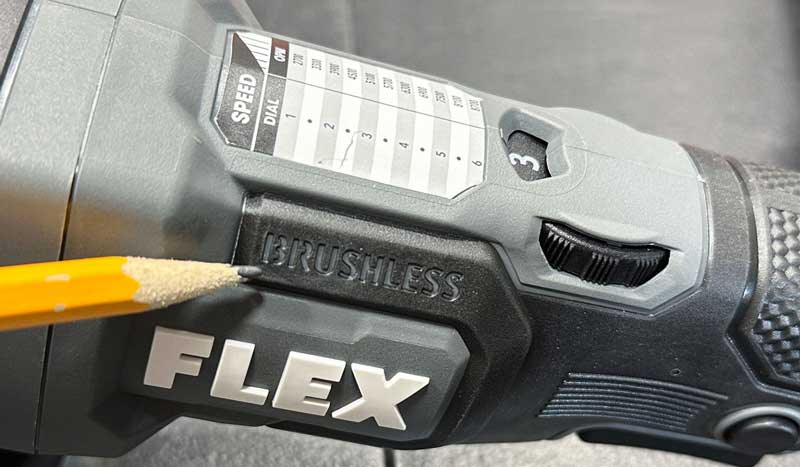
FLEX Brushless Electric Motor Technology: One of the more significant advantages of brushless DC motors is that they are between 85% and 90% more efficient than brushed motors which only have an 80% efficiency rate. For the most part, this high efficiency comes from the reduction of sound and heat, which in turn minimizes loss of power.
A brushed motor requires direct contact between the brushes and the commutator whereas brushless motors have fewer contact parts, for example there is no friction between the brushes and commutator, therefore require less maintenance through wear and tear.
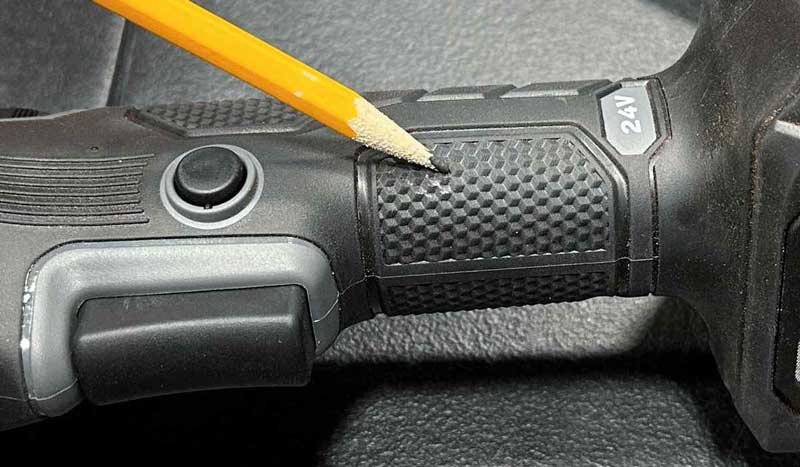
Textured Handle for Slip-Free Grip: Molded into the tool body are textured panels to make gripping the tool easier.
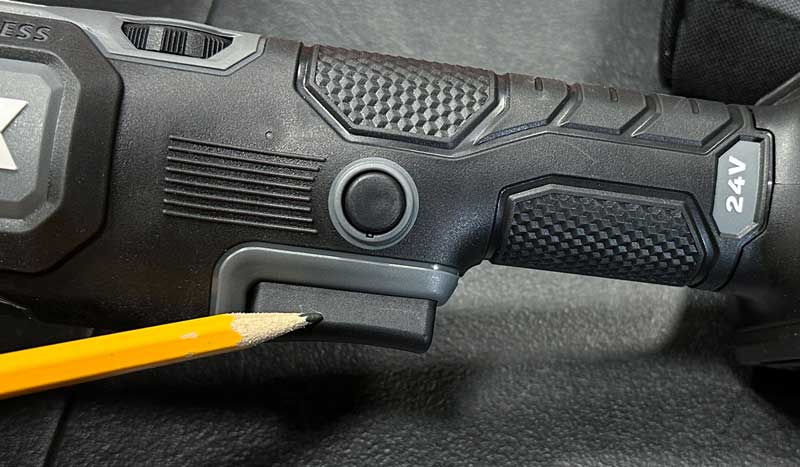
Large Variable Speed Trigger: Instead of a simple on/off speed trigger, all FLEX polishers come with an easy-start, variable speed trigger to give you precise control over power to the buffing pad.
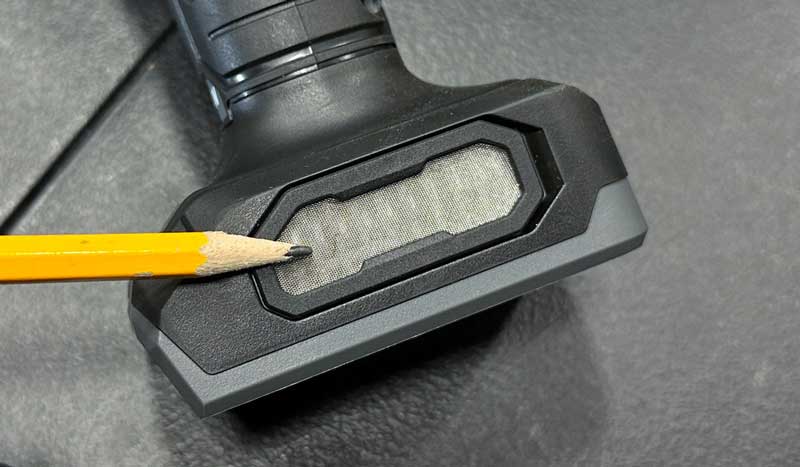
Stainless Steel Wire Mesh Fresh Air Intakes: These are important as the tool pulls air through the battery to cool it, and then through the tool body to help keep run temperatures down. The tiny mesh design allows for plenty of air movement while preventing dirt and dust from getting into the tool.
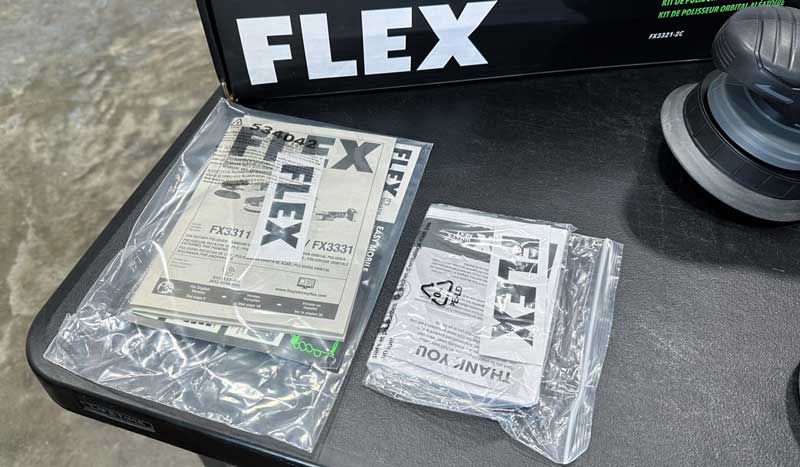
Owner’s Manuals: There are two included owners operating manuals included in the box. One for the polisher and one for the charger.
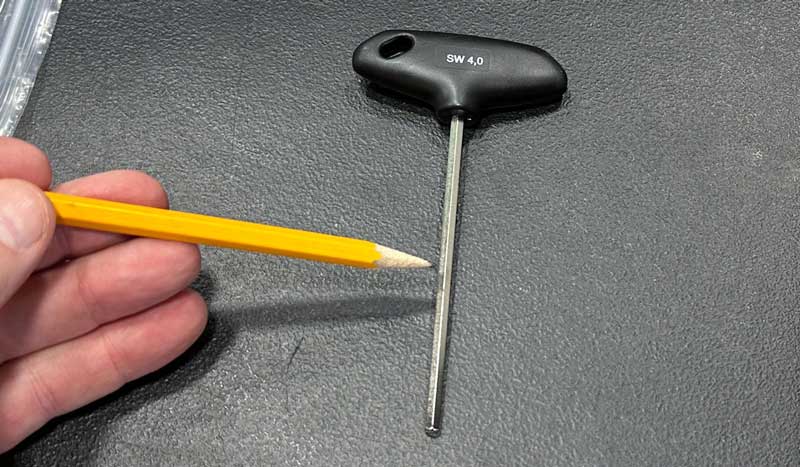
Backing Plate Hex Head Wrench: This is a 4.0mm Hex Head Wrench for removing the machine screws that attach the backing plates to the drive spindle.
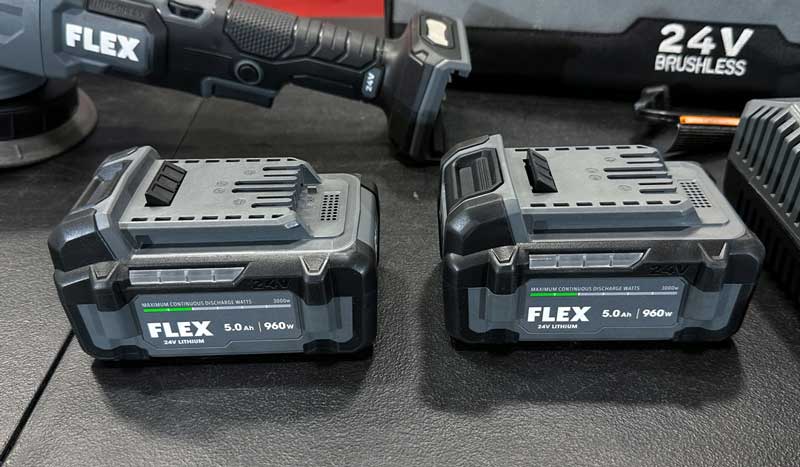
2 Each 5 AMP Batteries: The kit form comes with 2 each 5 Amp – 960 Watt Lithium Cylindrical Cell Batteries. The batteries are somewhat bulky, so after you’ve locked in your speed I recommend holding the battery with one hand while guiding the head with the other.
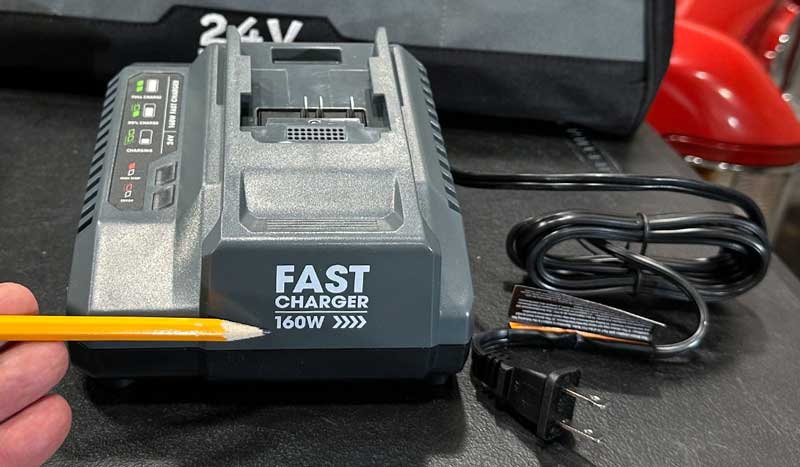
1 Each 160 Watt Battery Charger: Watt for watt, FLEX 24V chargers are faster than the competition. With more wattage in our base charger, dual-fan cooling, and a built-in intelligent processor, FLEX batteries spend less time on the sidelines and more time on the job.
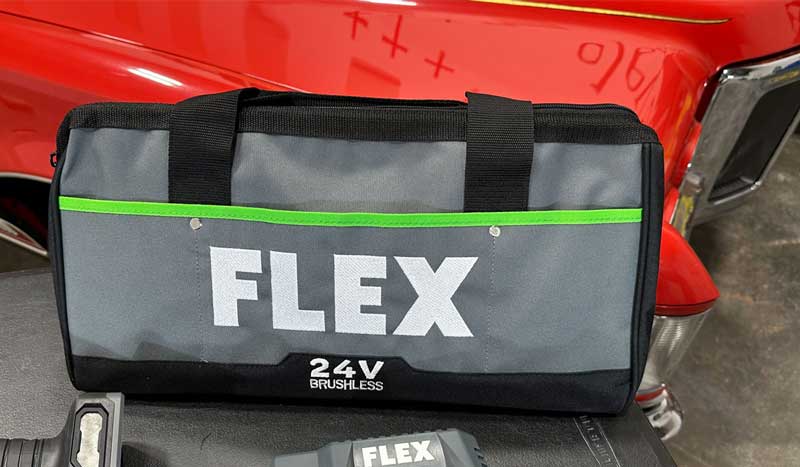
Sturdy Storage Bag: This strong heavy-duty construction with large zipper and handles makes this perfect for storing and transporting your FLEX Polisher with enough room to hold the tool, batteries, battery charger.
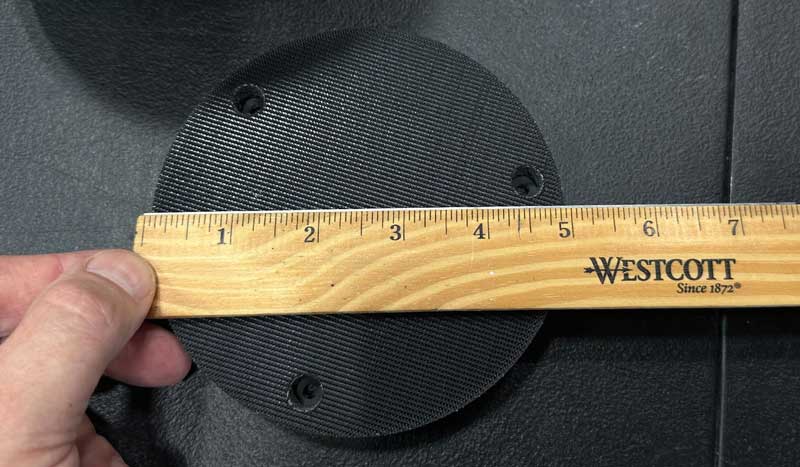
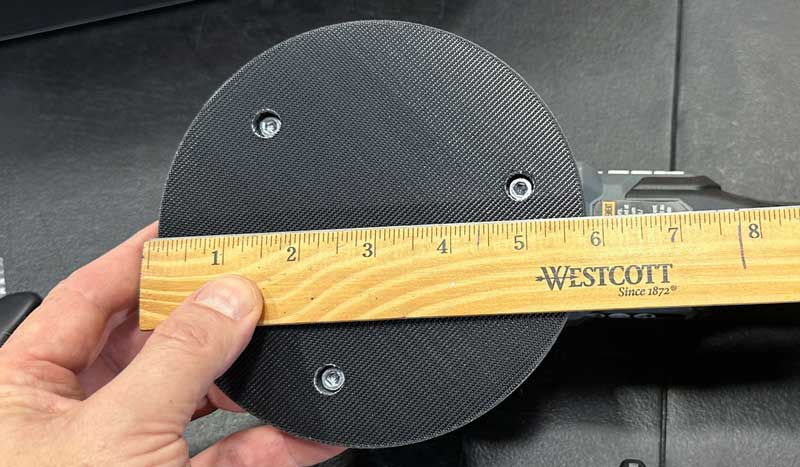
Two Backing Plates: The tool comes with a 6” backing plate already attached to the tool. There is also a 5” backing plate included.
Flex FX3321 24V Cordless 15mm Random Orbital Polisher: Review
Test Vehicle: 1970 Pontiac Grand Prix Model SJ — Custom Single Stage Paintwork
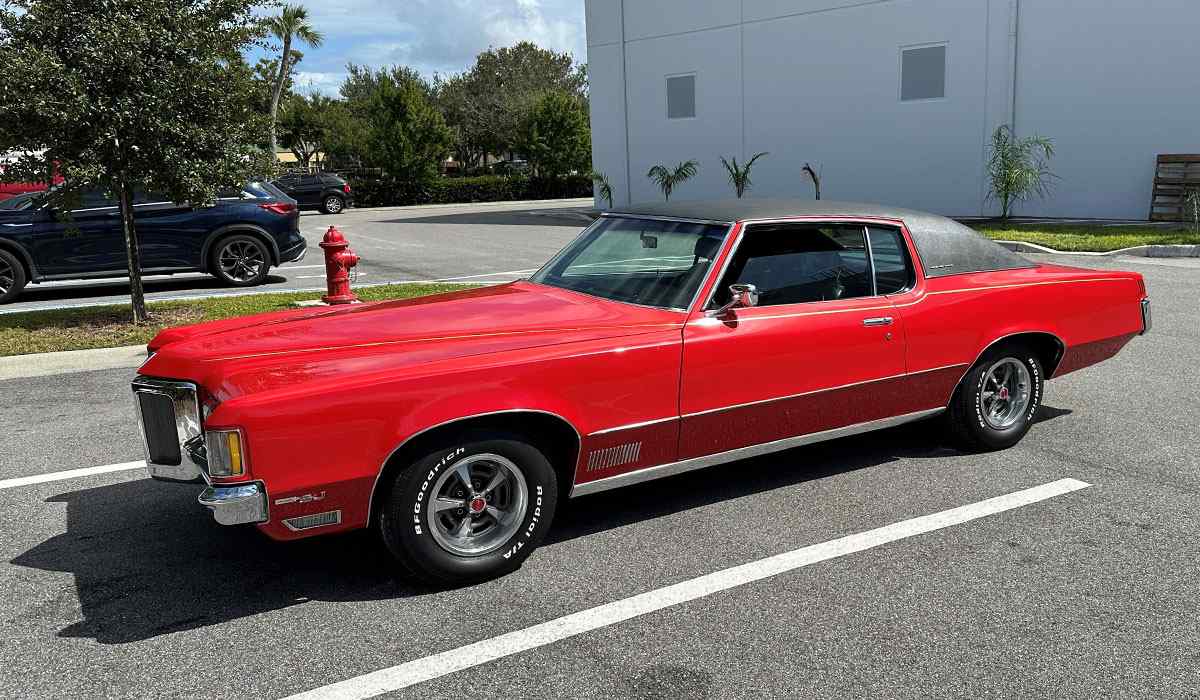
This is the same car I’ve already used for torture testing the new 24 Volt FLEX Cordless Rotary Polisher and the new 24 Volt FLEX Cordless 8mm Gear-driven Orbital Polisher. The finish on this car was in the worst condition of just about any car I’ve ever detailed. I’ll share before and after pictures at the very end of this article.
I’m happy to say that using the new cordless rotary polisher removed the majority of holograms, swirls, and scratches from the first paint correction step. Using the new cordless 8mm gear-driven orbital polisher I removed any holograms left by the fibers of the wool pad from the first step and actually left a very acceptable finish.
That said, the entire reason I chose this car was so that I could use all 3 tools on the same car, same paint, same protocol for torture testing the batteries as well as testing out the tool itself.
Polishing Procedure: Finishing Step
Like I said earlier, the Flex 24V cordless rotary and gear-driven orbital were enough to deliver an acceptably defect-free finish. Here are some before and after photos.
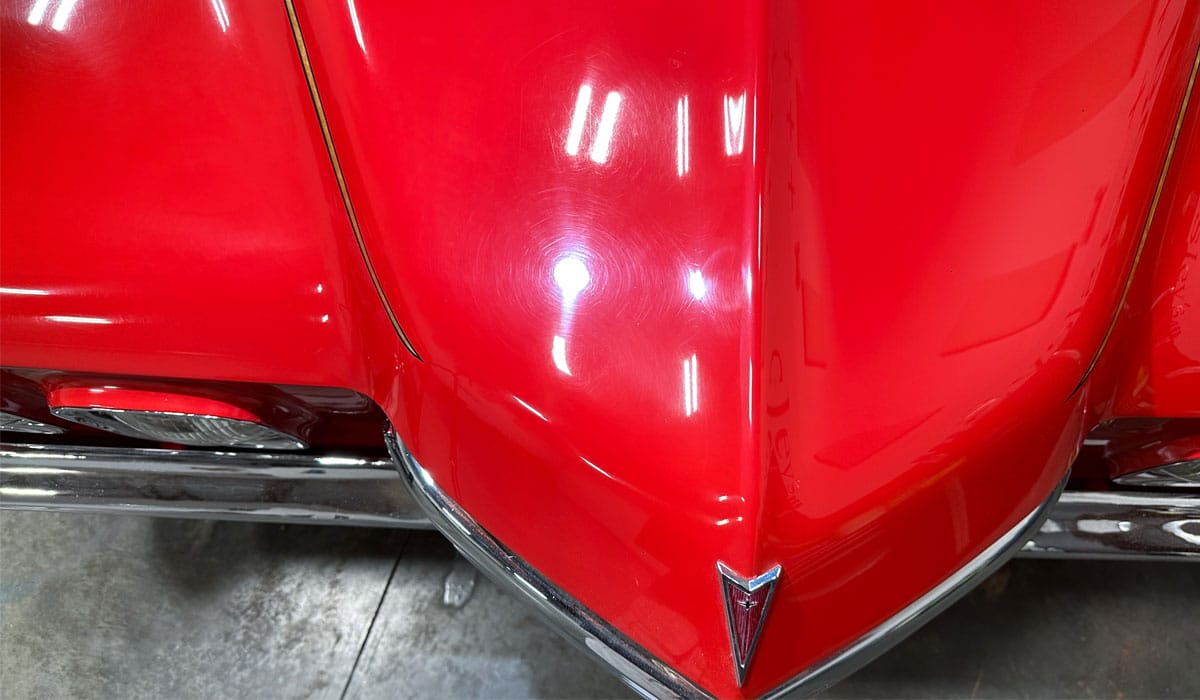
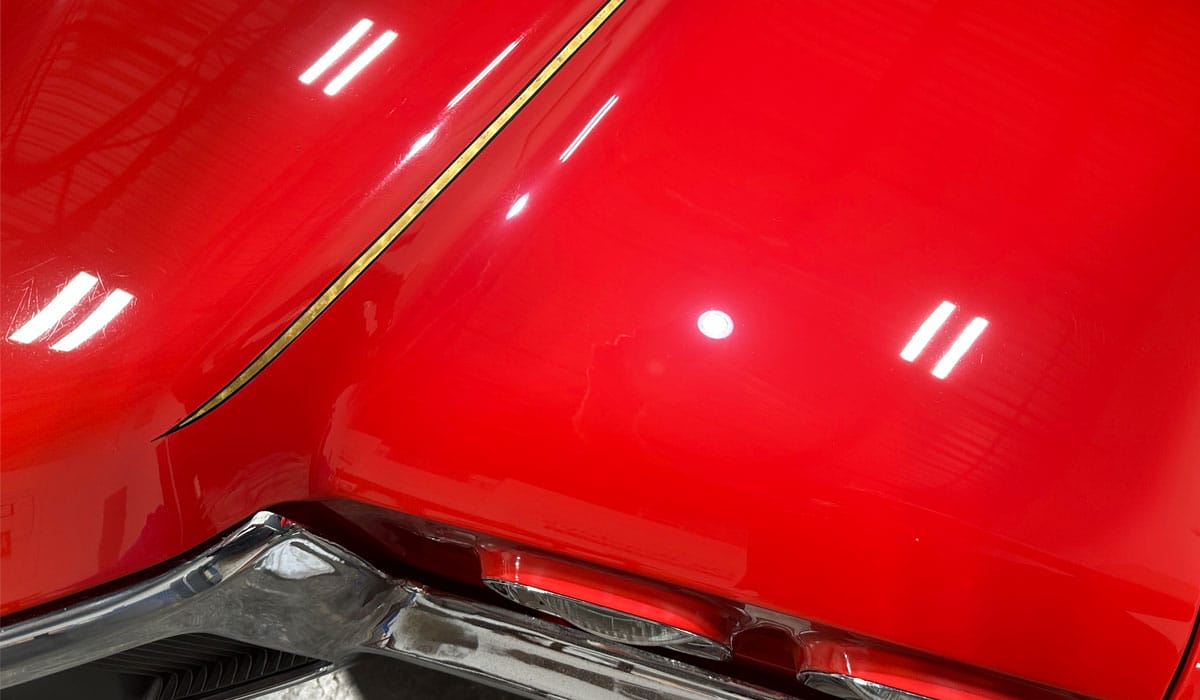
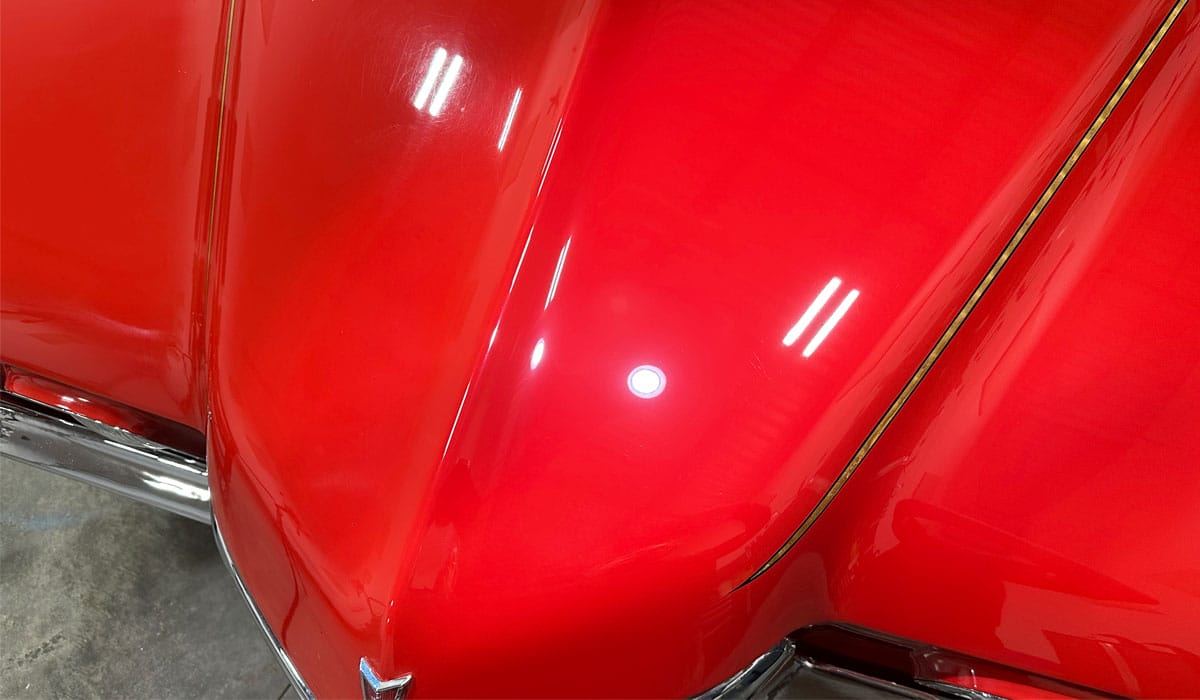
So, for this review, I’ll be refining the paint further to a brilliant gloss — which is something a free spinning random orbital polisher like this is perfectly suited for.
Battery Stress Test
As shared in the other three reviews and now this review, the way I tested these tools is NOT how most people do battery testing. What I do is insert a fully charged battery into the polisher and then turn the polisher on and run and use the tool exactly like I would if I were not making a video, that is buff out the paint like I normally would do, and then time how long the battery lasts.
Just like all the battery testing I’ve done for FLEX over the years, to really get a good idea for how long the battery will last, I focus on buffing without turning the polisher off unless necessary. For example, I will turn the tool off in order to get some fresh product, but this takes SECONDS.
In the real world, most of you will buff a section and then turn the tool off and wipe-off the residue, get some fresh product, maybe answer your phone, or get a drink of water. The longer you are NOT running the tool, the longer the battery life.
For me however, I’m TORTURE TESTING these tools and these batteries, so I try to run them SOLID, without stopping and then CLOCK how long the tool runs.

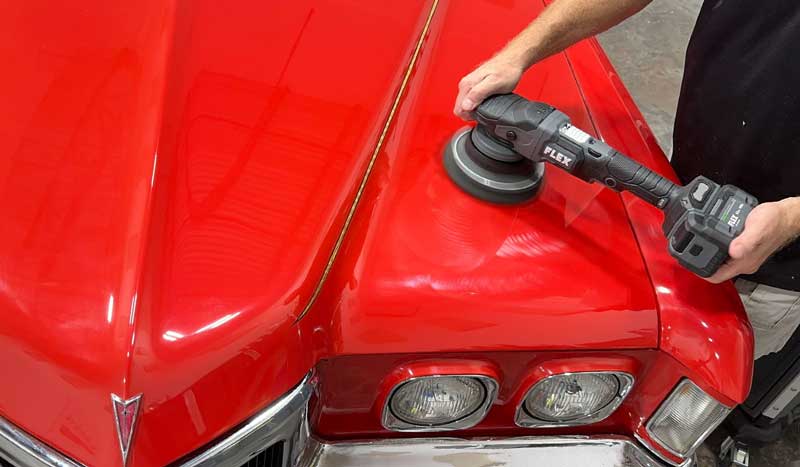
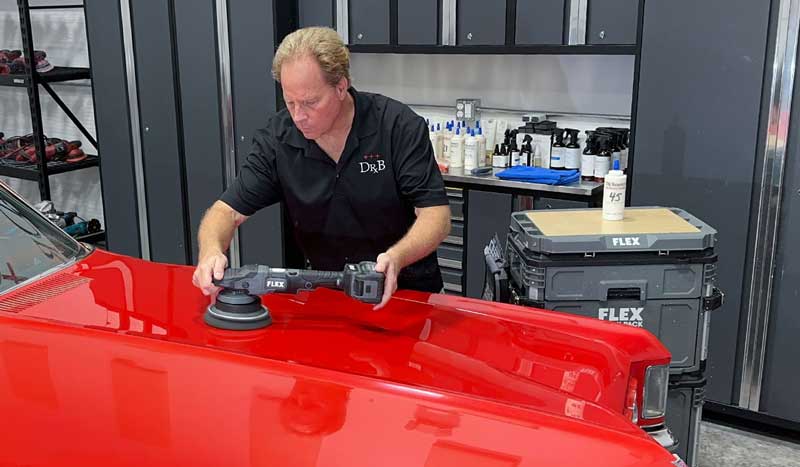
I polished the hood of this Pontiac, refining and perfecting the results using the new 24 Volt 15mm Random Orbital Polisher and as you can see by the clock I have resting on a microfiber towel on the windshield, the battery lasted an easy 26 minutes.
Keep in mind, this is solid run-time, this is NOT turning the polisher off to wipe the paint, get fresh product, check my phone, get a drink of water etc. MOST battery testing run times are calculated by NORMAL USE of the tool.
If you use this tool and this battery the way people normally buff out a car, the battery will last up to 45 minutes or longer. I personally think the way I test batteries is more conclusive and this is how everyone testing any brand of tool and battery should do it so we’re all on the same page.
Overall Impressions: Same Great Ease-of-Use, More Power & Runtime
The first thing I noticed about this new version of the original FLEX XFE15 150 18.0 free spinning 15mm long stroke random orbital polisher aka THE FINISHER was the same thing I found with the other two new 24 volt polishers: more power and more consistency throughout the battery’s run time. I will attribute this to the increase in voltage and the new lithium battery technology.
Besides the power and extended battery run-time, the tool was as easy to use as its predecessor. Even with the battery installed, it’s well-balanced and user-friendly. Free spinning random orbital polishers are physically easier to use than gear-driven orbitals and much safer than rotary polishers.
Beyond that, there’s only so much I can say just typing — the only real way to know if you like this type of drive action is to spend some time behind the tool.
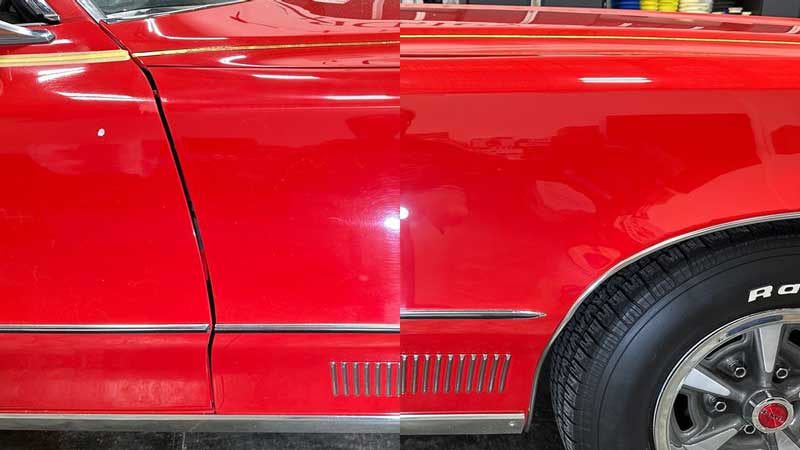
My Review: Recommended for Beginners & Finishing on Soft Paint
To be completely honest, I rarely use any brand of free spinning random orbital polisher EXCEPT if working on soft paint, clear plastics, and even final polishing on aluminum. Everyone has their own STYLE of detailing, and my style is I want to go as fast as possible while producing pro-quality results. For this reason, I rarely use free spinning random orbital polishers as there’s too much pad stalling as compared to any gear-driven orbital polisher, which has zero pad stalling.
That said, I know there are a LOT of people that are not in a hurry and much prefer the smoothness offered by free spinning random orbital polishers and I’m okay with this. Free spinning random orbital polishers are also a LOT easier to hold, control and move over body panels, so if you’re older, or young or have any type of physical limitations, then a free spinning random orbital polisher like this newest FLEX FX3321 will be a better choice for you.
As long as you have a way to go from start to finish and get to shiny paint, that’s really what’s most important.
I do love the freedom of no cord. Alas, and as good fortune would have it, most of us including me don’t get cars to detail with soft paint but when I do have a car with noticeably soft paint, the FLEX FINISHER is a great option for being able to finish out with a show car quality finish without the pad marring you sometimes get with more powerful tools.
Before & After Photos
Before:
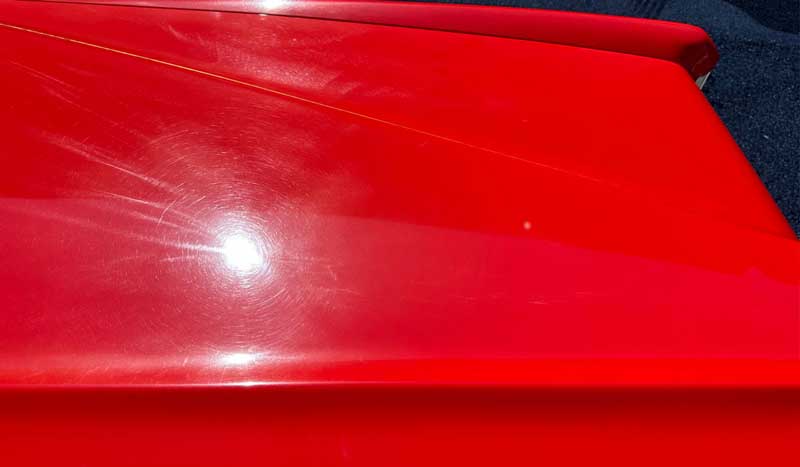
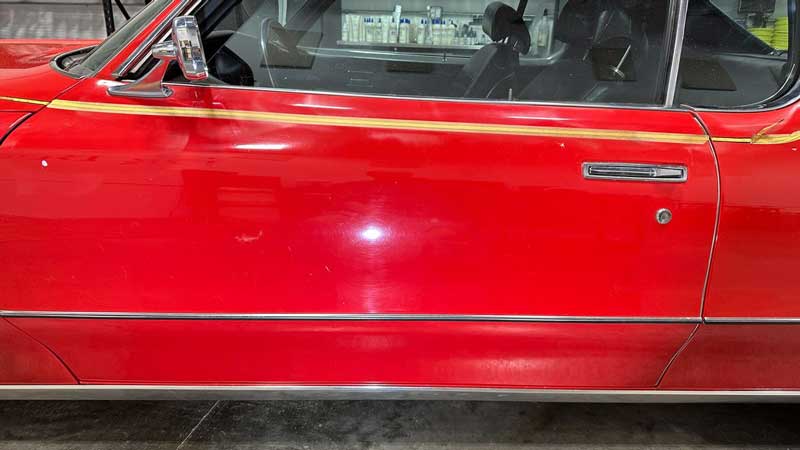
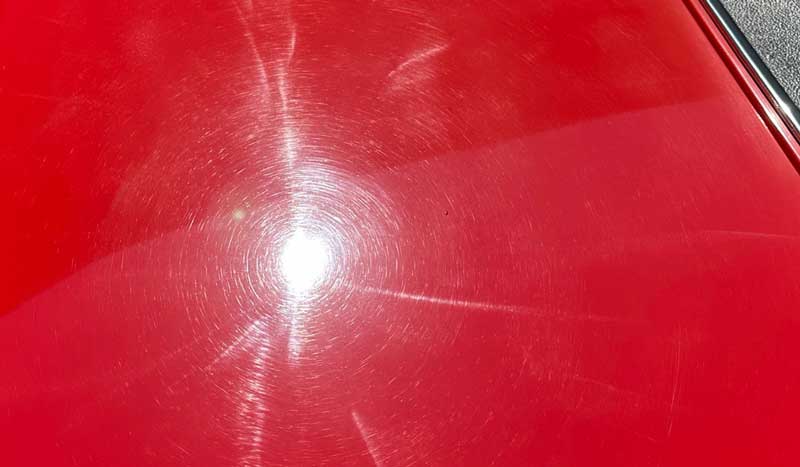
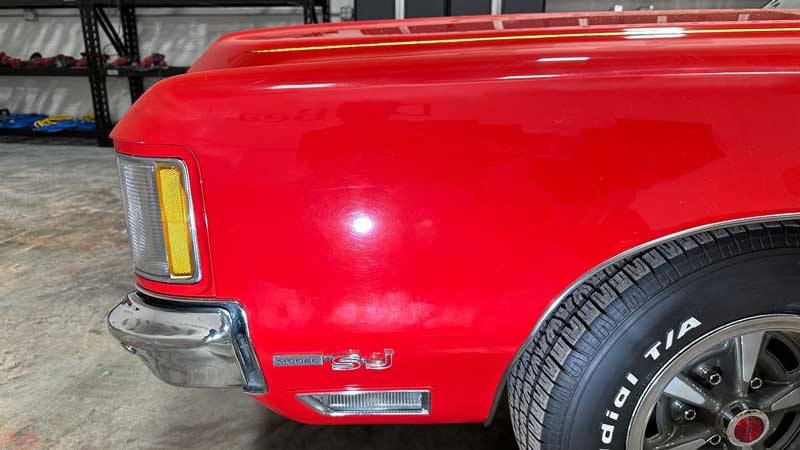
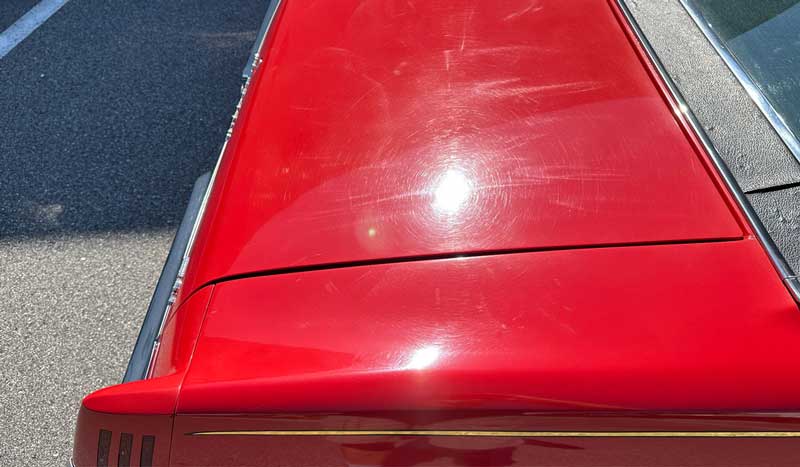
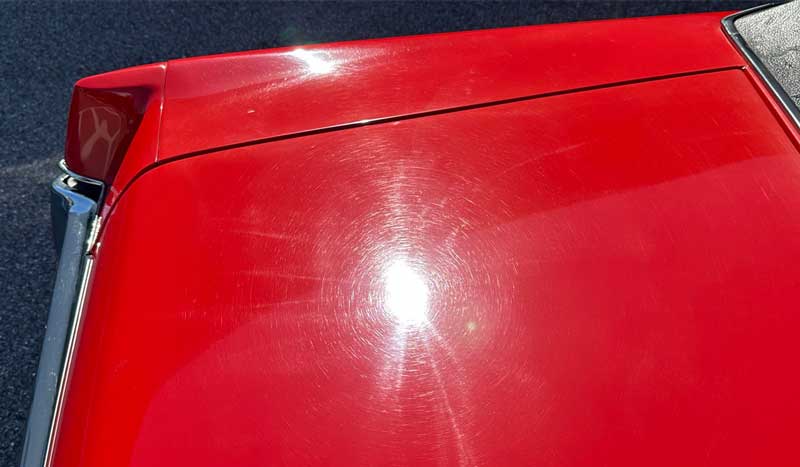
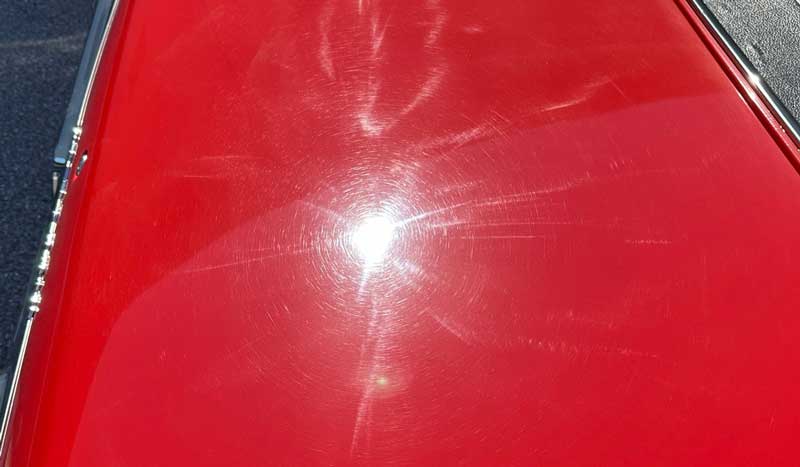
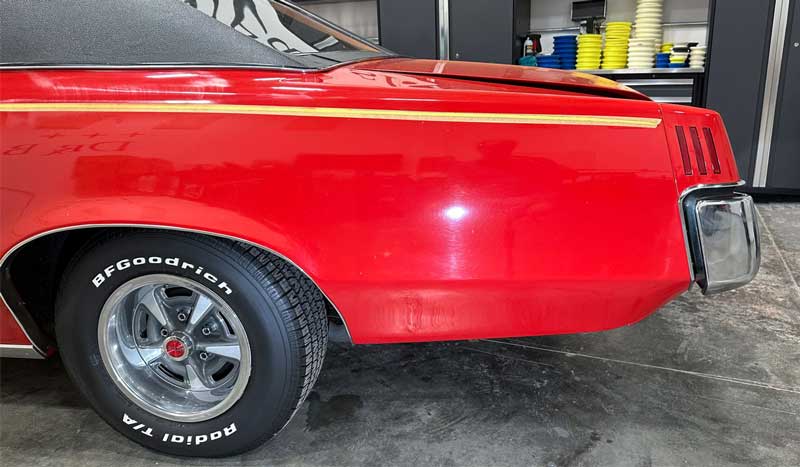
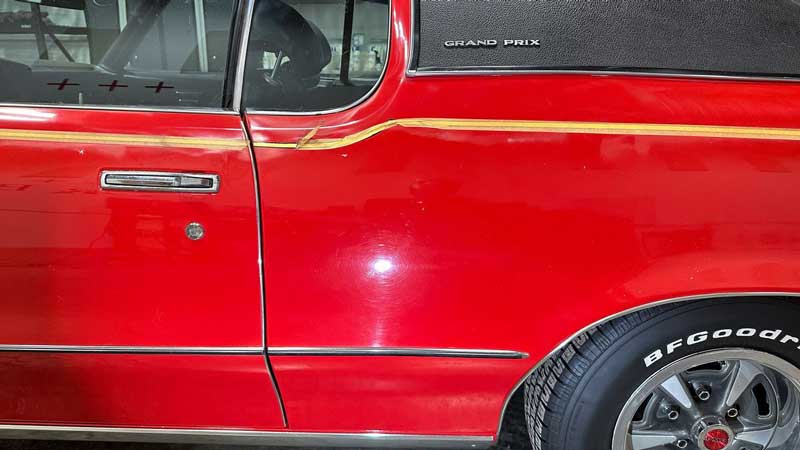
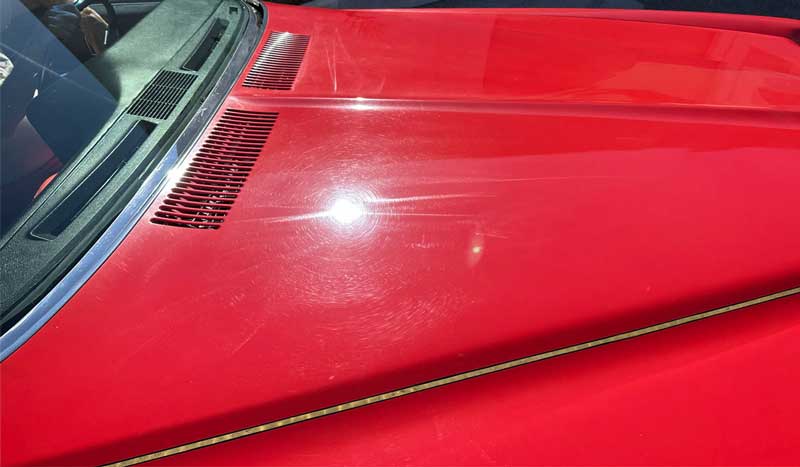
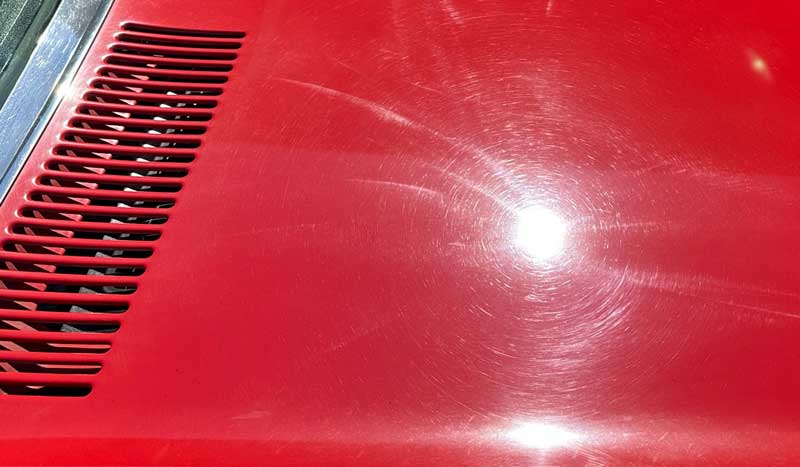
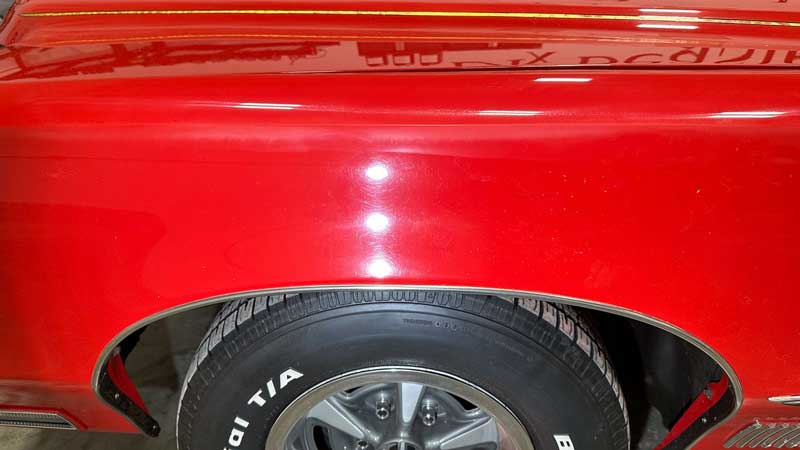
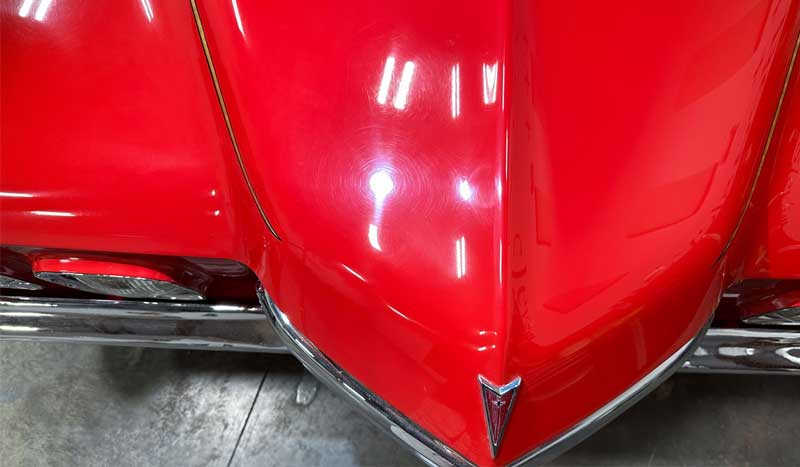
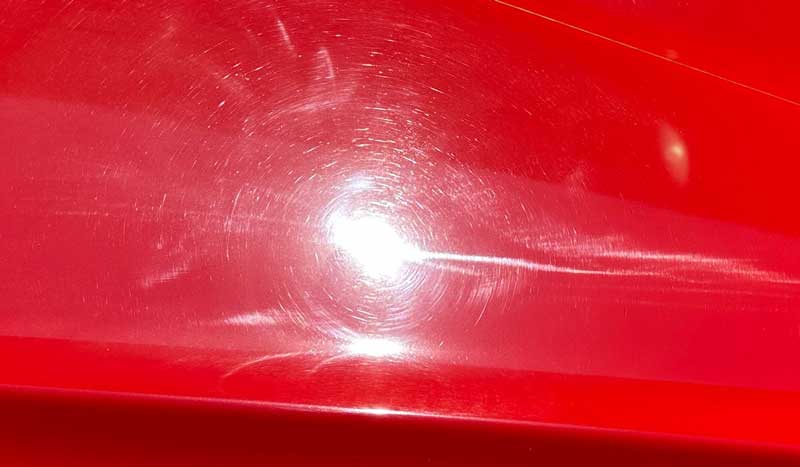
After:
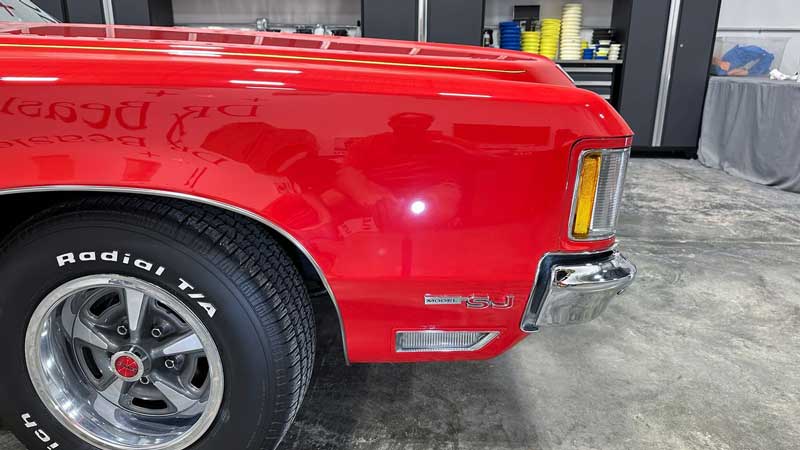
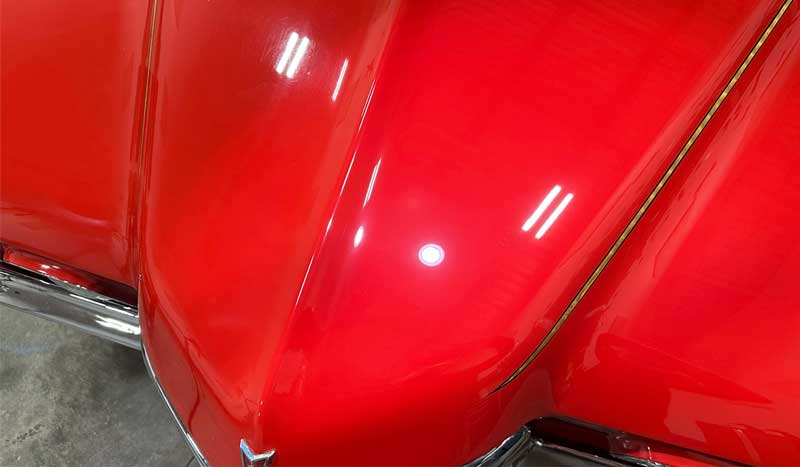
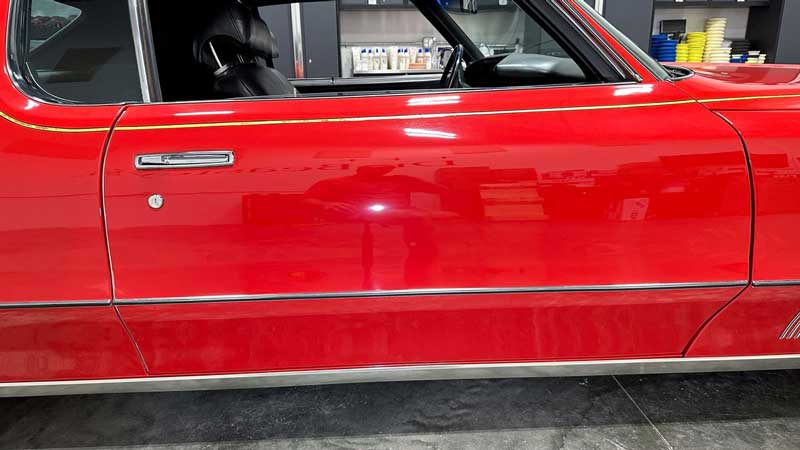
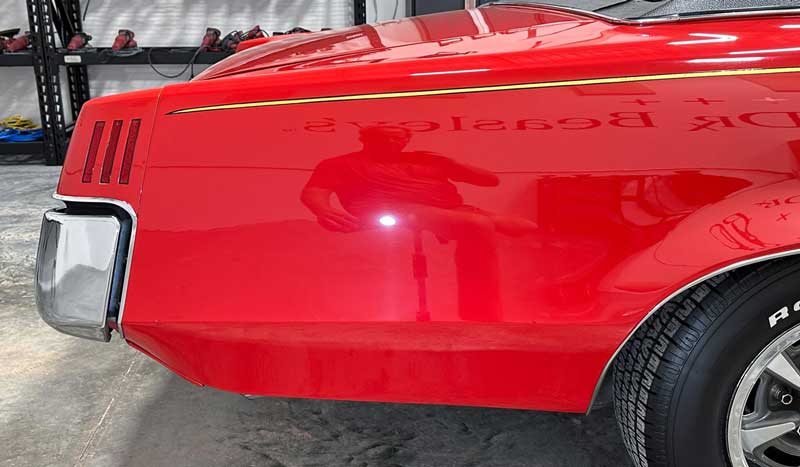
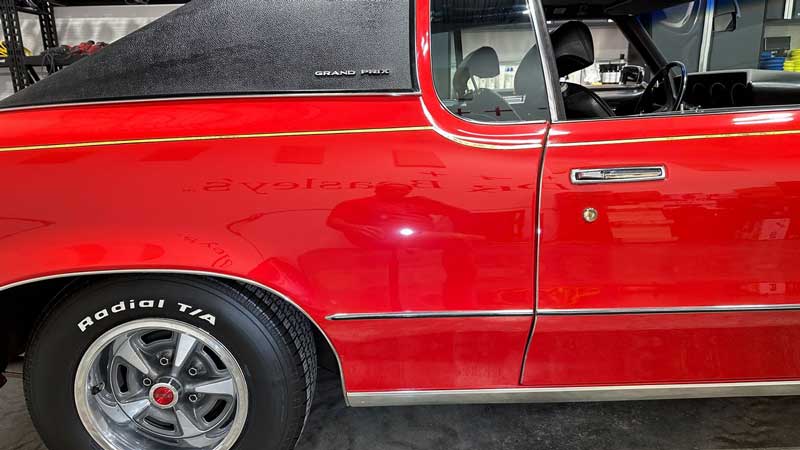
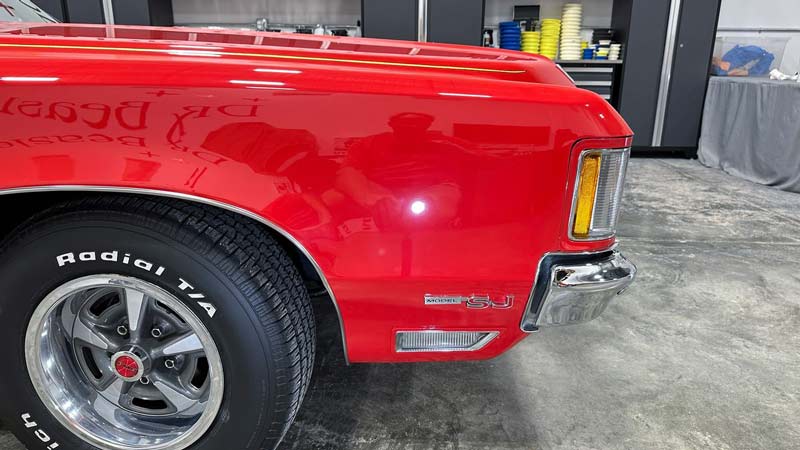
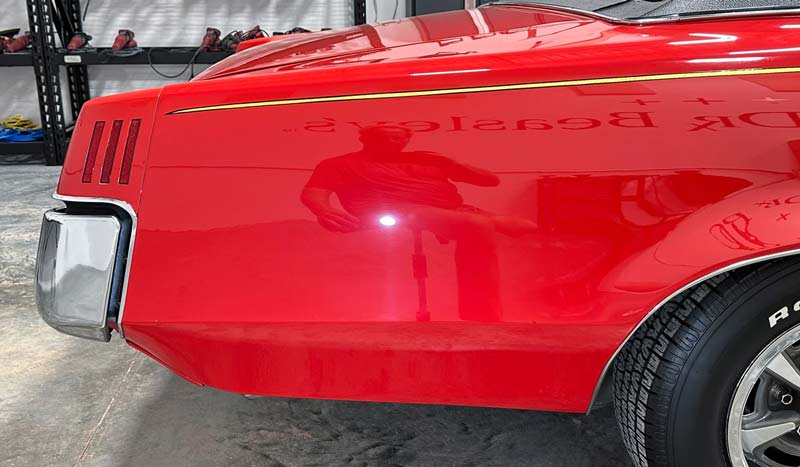
Battery Charger Stress Test
I ran the battery all the way down to empty charge, and then repeated the charging process documenting the time needed to bring a fully drained battery back to full charge. According to my trusty, dusty FLEX wrist watch, it took approximately 55 minutes.
The 160 Watt battery charger that comes in the box is fine for enthusiast detailers, but if you are a professional, or a do-it-yourselfer that prefers to have your batteries recharged faster, then spring for the 560 Watt Charger and cut the charging time in half.
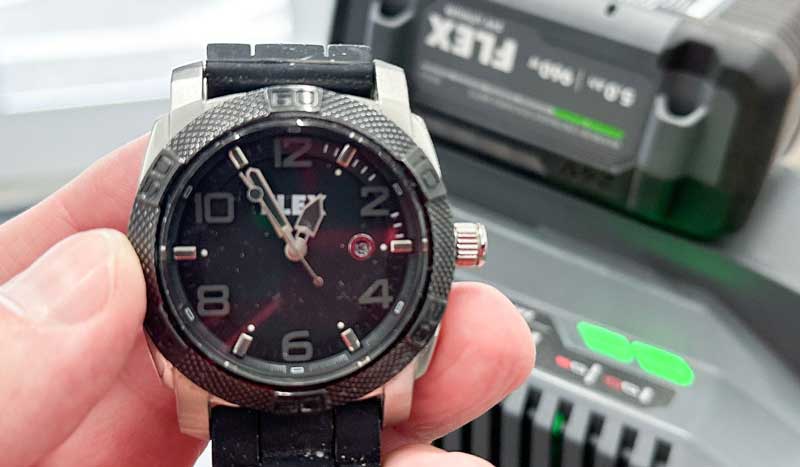
Three new FLEX 24 Volt Polishers = Three Dedicated Reviews
This is the third of three reviews for the new 24 volt FLEX polishers. Below are the links to the other two tool reviews. As I worked through using these tools, making videos, and writing these reviews, you can watch the transformation and extreme makeover to the 1970 Pontiac Grand Prix Model SJ as I used all three tools to torture test the tools and the lithium battery technology.
- Review: FLEX FX3331 24 Volt Cordless 8mm Gear-driven Orbital Polisher aka CBEAST
Look for my other blog articles and videos for all three tools on Dr. Beasley’s website.
Dr. Beasley’s List of Blog Articles
My Personal Offer to Help
I’ve been answering car detailing questions professionally since 2002 and moving forward, if after reading this article you have any questions about polishing and waxing, or how to use an AIO, my contact information is below, reach out to me, I’m always happy to help.
Would You Like to Learn How to Machine Polish Like a Pro?
Would you like to take your detailing skills to a higher level? Do you find you learn better by doing versus sitting in a chair looking at a PowerPoint presentation about car detailing?
Here at Dr. Beasley’s O.R., (Operating Room), in sunny Stuart, Florida, we teach the most hands-on car and boat detailing classes on planet Earth. And we prove it too. You can find write-ups on the Dr. Beasley’s Blog that photo-documents just how hands-on our classes are plus you’ll see the kinds of cars and boats you’ll be training on.
Click the link below to find the dates, locations, topics, and prices for all upcoming detailing classes.
Upcoming Detailing Classes – Prices – Info – Topics – Locations
And if you ever have any questions, always feel free to reach out to me personally via text, phone call or email.
I hope to see you in a future detailing class!
Sincerely,
Mike Phillips
Chief Education Officer for Dr. Beasley’s
Mike@drbeasleys.com
760-515-0444

